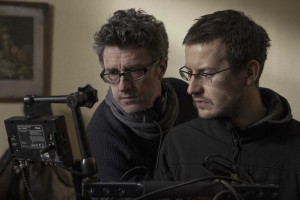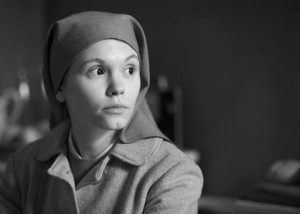
Ida, the starkly beautiful black-and-white Polish movie that has been nominated for the best foreign film Oscar, has two directors of photography who are also both up for an Academy Award for best achievement in cinematography. Ryszard Lenczewski started shooting the film but after 10 days became seriously ill and handed off DP duties to Lukasz Zal, the film’s camera operator, who lensed the rest of the movie.
Both contributed in their own ways to Ida’s luminous, austere and introspective look – strikingly framed shots and minimal camera movement – to capture the movie’s brooding intensity. Directed by Pawel Pawlikowski, Ida takes place in 1960s Communist Poland and tells the story of a young novitiate who just before becoming a nun is told by her wayward aunt that she is Jewish and that her parents were killed during the Nazi occupation and lie in unmarked graves.
Lenczewski spent six months prepping for the shoot by taking some 3,000 still photographs. A number ended up duplicated almost exactly in the film. “For many years, the way I’ve prepared for a film as a creative cinematographer was to shoot photographs,” he said. “I note the moods of the places I visit, the lighting and the atmosphere, and I look for a different ways of framing. This is my first artistic impression, and the way I help create the style of the film.”
The film was shot in a 4:3 aspect ratio that invoked black-and-white classics of a much earlier era of filmmaking. Paradoxically, it was created using the latest in camera technology. Ida was actually shot in color with a digital ARRI Alexa, using Arri/Zeiss Ultra Prime lenses. Then it was converted into carefully calibrated black and white in a digital intermediate during postproduction.

Stepping in as DP on short notice was both demanding and exhilarating for Zal, and an unexpected career boost. “While working on Ida all I could think about was the movie. I lived and breathed that film,” he observed. Working with Pawilowski was “a constant dialogue, creative discussion and search for the best solutions,” he said.
“Since I only knew locations from the photographs that were taken during prep, everything was new to me,” said Zal. “But I think it worked to my advantage as it gave me a fresh perspective. Pavel and I started out by playing with those pictures. He called it ‘fantasizing’.”
The most important part of the creative process took place on the set. “Piece by piece, we would put this movie’s reality together,” said the DP. “In the evenings I talked with the actors about the scene we would be filming in the morning. I was first on the set every morning trying to find the precise ways of shooting it.”
“We eliminated color and camera movements, so composition and lighting was all we had left,” Zal noted. “We wanted to build essential frames that would have strong emotional impact and speak about the space beyond the frame. In the scene where Ida is waiting at the bus station, for example, we feel a kind of isolation, an emptiness, she is somehow lost in the frame. This tension in the frame speaks about the souls of our characters and their world.”
As for the lighting, the DP wanted to create a look that was “very simple and natural, like the other elements in this movie. I wanted to find a proper contrast between the characters and their environments.”
Shooting with the Alexa impressed Zal with its “subtle gradations and noble structure of the picture. It also made it possible to work with very low lighting.” The Alexa’s capabilities, he points out are most visible in the night scenes, “especially in the scene with the figure of Christ, when the light was very low. This was a very important scene. We had very little time to shoot it. We filmed it at dawn and the entire crew really lived up to the task. It came out exactly as I imagined it.”
While shooting in color, there were black-and-white monitors on the set to indicate what it would like when converted. “The material filmed in color is full of information about blacks and whites,” said Zal. A wide and subtle range of greys was created in post by adding a slight amount of grain. “That grain helped deteriorate the digital image a bit to prevent it from looking “too clean.”
Ida has already had some cinematography honors bestowed on it. In 2014 it got the Spotlight Award from the American Society of Cinematographers. And it won the Golden Frog at Camerimage, an annual festival honoring cinematographers.





